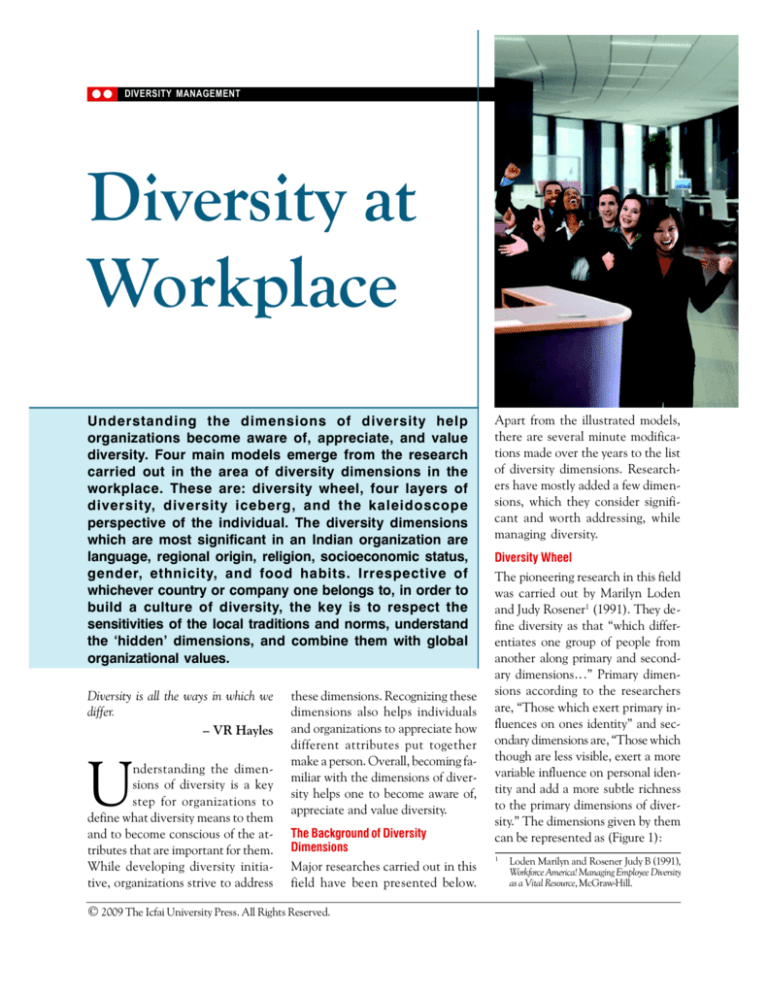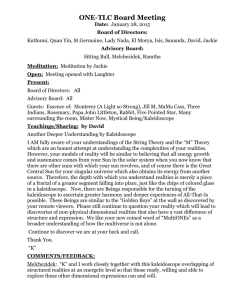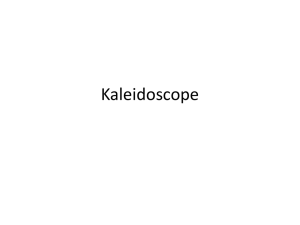
DIVERSITY MANAGEMENT
Diversity at
Workplace
Understanding the dimensions of diversity help
organizations become aware of, appreciate, and value
diversity. Four main models emerge from the research
carried out in the area of diversity dimensions in the
workplace. These are: diversity wheel, four layers of
diversity, diversity iceberg, and the kaleidoscope
perspective of the individual. The diversity dimensions
which are most significant in an Indian organization are
language, regional origin, religion, socioeconomic status,
gender, ethnicity, and food habits. Irrespective of
whichever country or company one belongs to, in order to
build a culture of diversity, the key is to respect the
sensitivities of the local traditions and norms, understand
the ‘hidden’ dimensions, and combine them with global
organizational values.
Diversity is all the ways in which we
differ.
– VR Hayles
U
nderstanding the dimensions of diversity is a key
step for organizations to
define what diversity means to them
and to become conscious of the attributes that are important for them.
While developing diversity initiative, organizations strive to address
these dimensions. Recognizing these
dimensions also helps individuals
and organizations to appreciate how
different attributes put together
make a person. Overall, becoming familiar with the dimensions of diversity helps one to become aware of,
appreciate and value diversity.
The Background of Diversity
Dimensions
Major researches carried out in this
field have been presented below.
362009
HRM
August 2009
©
TheReview
Icfai University
Press. All Rights Reserved.
Apart from the illustrated models,
there are several minute modifications made over the years to the list
of diversity dimensions. Researchers have mostly added a few dimensions, which they consider significant and worth addressing, while
managing diversity.
Diversity Wheel
The pioneering research in this field
was carried out by Marilyn Loden
and Judy Rosener1 (1991). They define diversity as that “which differentiates one group of people from
another along primary and secondary dimensions…” Primary dimensions according to the researchers
are, “Those which exert primary influences on ones identity” and secondary dimensions are, “Those which
though are less visible, exert a more
variable influence on personal identity and add a more subtle richness
to the primary dimensions of diversity.” The dimensions given by them
can be represented as (Figure 1):
1
Loden Marilyn and Rosener Judy B (1991),
Workforce America! Managing Employee Diversity
as a Vital Resource, McGraw-Hill.
DIVERSITY AT WORKPLACE
Four Layers of Diversity
Gardenswartz and Rowe 2 (1998)
built upon the primary and secondary dimensions and added two more
layers to the diversity wheel. According to them, diversity consists
of four layers, i.e., four concentric
circles (Figure 2). Personality of a
person is at the core of the wheel
and it covers all those aspects which
constitute the personal style of the
person. Internal dimensions and
external dimensions are similar to
the primary and secondary dimensions explained by Loden and
Rosener. The outermost layer is of
the organizational dimensions.
These are corporate or institutional
affiliations and are associated with
past and present experiences.
Saumya Goyal
HR Researcher, Hyderabad.
The author can be reached at
saumya.goyal@gmail.com
defined as, “The collective, all encompassing mix of human differences and similarities along any
given dimension.” With so many
dimensions in existence, they came
out with the iceberg model to depict the diversity dimensions. As an
analogy to the iceberg, these dimensions have three facets. Above the
water line are the most visible dimensions or the primary dimensions. Just below the surface, lie the
secondary dimensions which are
Diversity Iceberg
revealed with time, and the tertiary
Rijamampianina and Carmichael3 dimensions lie much below the sur(2005) propose that diversity be re- face. These are the core dimensions
Figure 1: Dimensions of Diversity Wheel
and provide the real essence of diversity. This model is represented
in Figure 3. The model is illustrative, with only a few possible dimensions depicted in the figure.
Kaleidoscope Perspective of the
Individual
Maier4 (2005) argued that previous
researches on diversity have focused
on limited dimensions and out of
these, a few, such as ethnicity, race
and gender, are over-emphasized.
According to him, an individual can
be modeled by a kaleidoscope. Just
as a kaleidoscope contains certain
amounts of particles of various
shapes and colors, an individual is a
composition of various diverse attributes. The individual kaleidoscope can be represented as a multicolored pie chart, with each pie depicting a unique attribute, and size
of the pie illustrating the importance that an individual gives to a
particular attribute. On the basis of
this perspective, Maier defines diversity as, “the variety of kaleidoscope.” Figure 4 illustrates the kaleidoscope perspective of diversity.
What Dimensions Have Global
Organizations Adopted?
Organizations which support diversity have either adopted one of these
models or have developed their own.
Here are a few examples of the dimensions which global organizations consider as important.
2
3
Secondary Dimensions
Primary Dimensions
Source: www.diversitycentral.com
4
Gardenswartz Lee and Rowe Anita (1998),
“Managing Diversity: A Complete Desk Reference & Planning Guide”, McGraw-Hill.
Rijamampianina Rasoava and Carmichael
Teresa (January 2005), “A Pragmatic and
Holistic Approach to Managing Diversity”,
Problems and Perspectives in Management.
Maier Christoph (2005), “A Conceptual
Framework for Leading Diversity”, Int. J. Human Resources Development and Management,
Vol. 5, No. 4, pp. 412–424.
August 2009
HRM Review
37
DIVERSITY MANAGEMENT
Figure 2: Four Layers of Diversity
elements, which help define an individual and influence the way he or she functions. These are similar to the secondary dimension. The workplace dimension is similar to the Gardenswartz and Rowe’s
organizational dimension.
Daimler9,10
*Internal and external dimensions are adapted from Marilyn Loden and
Judy Rosener
Source: www.gardenswartzrowe.com
Figure 3: Diversity Iceberg
International Business Machines
Corporation5
Secondary Dimensions:
• Religion
• Culture
• Sexual Orientation
• Thinking Style
• Geographic Origin
• Family Status
• Lifestyle
• Economic status
• Political orientation
• Work experience
• Education
• Language
• Nationality
Tertiary Dimensions:
• Beliefs
• Assumptions
• Perceptions
• Attitudes
• Feelings
• Values
• Group norms
IBM has adopted the diversity
wheel of Loden and Rosener. It acknowledges the importance of these
dimensions on culture and values
the diversity in its workforce.
General Motors6,7
GM has also incorporated the Loden
and Rosener diversity model. This
model was also used to assist the development of the General Motors
Diversity Logo. GM’s diversity logo
is illustrated in Figure 5.
Sun Microsystems8
The three dimensions of global inclusion which Sun has adopted are
Human, Cultural and Workplace.
The human dimension includes attributes which are visible to others.
This resembles the primary dimensions given by Loden and Rosener.
The elements of cultural dimension
are less visible and comprise those
38
HRM Review
August 2009
Daimler has introduced a ‘42 dimensions’ program
to enable a better understanding of comprehensive
diversity. The figure of ‘42’ is arbitrary and represents several diversity attributes of an individual.
As a German automobile manufacturer, it follows
the German Equal Opportunities Act (AGG) and
pays special attention to a few personal dimensions
of diversity. These are: race and ethnic origin, gender, religion and worldview, age, and sexual identity.
The ‘42 dimensions’ model in a way resembles Maier’s
kaleidoscope perspective of an individual, as it suggests that an individual is made up of a combination
of varied attributes (Figure 6). The 42 dimensions
are given in table.
Primary Dimensions:
• Race
• Ethnicity
• Gender
• Age
• Disability
Source: A Pragmatic and Holistic Approach to Managing Diversity, Rijamampianina Rasoava
and Carmichael Teresa
5
6
7
8
9
10
http://www-01.ibm.com/software/globalization/topics/diversity/diversity.jsp
http://www.gm.com/corporate/responsibility/diversity/employee_diversity.jsp
http://www.gm.com/corporate/responsibility/diversity/diversity_initiatives.jsp
http://www.sun.com/aboutsun/globalinclusion/dimensions.html
http://www.daimler.com/dccom/0-5-1096059-1-1098886-1-0-0-1161462-0-0-135-876574-0-0-00-0-0-0.html
http://www.daimler.com/Projects/c2c/channel/documents/
1652464_daimler_sust_2008_reports_sustainabilityreport2008diversity_en.pdf
DIVERSITY AT WORKPLACE
Figure 4: Example of Kaleidoscope
Compositions of an Individual
Middle age
Animal lover
Professor
Indian
Urban
MBA
Women
Hindu
lear
Nuc mily
fa
Mother
Raytheon 11 :
Raytheon has developed its own diversity wheel which represents equal
importance being given to demographic, as well as non-demographic
attributes of a person (Figure 7). The
diversity wheel illustrates those
traits which are identified as important in order to make the company’s
culture strong and unique.
UBS 12
At UBS, diversity is defined across a
continuum, ranging from the more
visible aspects, like gender and
ethnicity, to the less visible aspects, like
function and thought. The visibility
continuum is illustrated in Figure 8:
India – A Mosaic of Diversity
Being one of the oldest civilizations
in the world, the concept of diversity in India has been existing since
ages. Its people are culturally diverse
and religion plays an important role
in the life of the country. Scholars
estimate that only the continent of
Africa exceeds the linguistic, cultural, and genetic diversity of India.13
With the country boasting of such
diverse population, the Indian workplace also reflects this diversity and
constitutes people from varied backgrounds, cultures, status, etc. The
diversity dimensions which are
most significant in an Indian organization are discussed below.
Table: Diversity at Daimler – The 42 Dimensions of Diversity
1. Addiction
2. Age
3. Authority handling
4. Character
5. Clothing
6. Communication style
7. Courage
8. Culture
9. Definition of quality
10. Disability
11. Eating habits
12. Education
13. Employment
14. Ethics
15. Ethnic background
16. Experience
17. Family
18. Family status
19. Gender
20. Hierarchy
21. History
22. Humor
23. Intelligence
24. Interests
25. Language
26. Language proficiency
27. Law
28. Leadership style
29. Mentality
30. Morale
31. Nationality
32. Physical ability
33. Power
34. Professional style
35. Religion
36. Sexual identity
37. Stress handling
38. Subject matter
competence
39. Time handling
40. Values
41. Weight
42. Work-life balance
Source: www.daimler.com
Diversity Dynamics in the Indian
Workplace
There are certain dimensions which
have shaped India’s present workplace environment. These are: language, regional origin, religion, socioeconomic status, ethnicity and
food habits. Each dimension is explained in brief below:
Language: According to India’s
national census, 114 languages
and 216 dialects are spoken in
the country. Eighteen Indian
languages and English, have
been given official status by the
central or state governments.14
Regional Origin: Differences in
the way people live and work also
Figure 5: GM’s Diversity Logo
stems from the regional origin.
People from the northern part
of India are referred to as North
Indians and people from the
southern states are referred to as
South Indians. Apart from this,
people are also associated with
their state of birth or where
their ancestors belong to. For
example, Gujaratis are ‘North
Indians’ from the state of
Gujarat.
Religion: Around 80.5% of the
people in India practice Hinduism, a religion that originated
here. Another 13.4% are Muslims, and other religious groups
include Christians, Sikhs, Buddhists, Jews and Jains.15
Socioeconomic Status: This dimension is predominantly based
11
12
13
14
Source: www.gm.com
15
http://www.raytheon.com/diversity/approach/
UBS diversity brochure. Available at: http:/
/www.ubs.com/1/ShowMedia/about/
d i v e r s i t y ? c o n t e n t I d =
160533&name=UBS_Diversity.pdf
United States Library of Congress, Note on
Ethnic groups (2004), “India, a Country
Study”, Available on http://lcweb2.loc.gov/
frd/cs/profiles/India.pdf
http://encarta.msn.com/
text_761557562__0/india.html
http://encarta.msn.com/
text_761557562__0/india.html
August 2009
HRM Review
39
DIVERSITY MANAGEMENT
Figure 6: Illustration of Various Diversity Attributes That
Constitute an Individual
Figure 7: Raytheon Diversity Wheel
Education
Gender
Identity and
Expression
Geographic
Location Functional
Discipline Nationality
Ethnicity
International
Work
Experience
Age
Building an
Inclusive
Culture
Language
Race
Veterans
Hierarchy
Status
Sexual
Oreintation
Gender
Family
Situation
Legacy
Company
Physical
Ability/
Disability
Religion
Source: www.raytheon.com
Source: www.daimler.com
Figure 8: UBS Diversity Visibility Continuum
Visible
Invisible
Gender • Ethnicity • Age • Disability • Sexual Orientation • Religion • Function • Thought
Source: www.ubs.com
on one’s caste. The caste system
in India is more than 3,000 years
old and conceived as a division
of labor based on ability. There
are four main castes in the
Hindu religion, which are further broken down to thousands
of smaller caste groups. Today’s
workforce comprises of diverse
people, irrespective of their
caste.
Gender: 48.3% of India’s population constitutes women and
their numbers are gradually increasing in the urban workforce.
Especially, the service-based industries are witnessing an increase in the proportion of
women employees over the years.
For example, Information Technology and Information Technology Enabled Services sectors
40
HRM Review
August 2009
employ nearly 30% women in
their workforce.
Ethnicity: Most of the Indians
are either Indo-Aryans or
Dravidians. Generally, the
‘North Indians’ are Indo-Aryans
and the ‘South Indians’ are
Dravidians. A few groups, especially in the north- eastern
states, are Austro-Asiatic; a few
are Sino-Tibetans and various
other smaller ethic groups also
exist across the country.
Food Habits: India is one those
few countries where a large number of populations is non-meat
consuming or ‘vegetarians’. The
food habits are mostly guided by
one’s religion and caste, but with
the younger generation, this
practice is not as ‘strict’ as it was
earlier. Interestingly, the food
habits are also influenced by one’s
region as climate is a major deciding factor on the availability
of a particular type of crop.
Conclusion
Scholars have presented comprehensive, all-attribute-encompassing models of diversity dimensions.
Any organization which truly understands the importance of diversity in its workforce can adopt any
of the models to understand the dimensions. Most importantly, in order to build a culture of diversity,
the key is to respect the sensitivities of local traditions and norms,
understand the ‘hidden’ dimensions, and combine them with global organizational values.
Reference # 12M-2009-08-06-01








